Balbharti Maharashtra State Board Class 8 Science Solutions Chapter 15 Sound Notes, Textbook Exercise Important Questions and Answers.
Maharashtra State Board Class 8 Science Solutions Chapter 15 Sound
Class 8 Science Chapter 15 Sound Textbook Questions and Answers
1. Fill in the blank with appropriate word:
Question a.
The region in a sound wave, with higher pressure and density is called ………….. and that with low pressure and density is called ……….. .
Answer:
The region in a sound wave, with higher pressure and density is called compression and that with low pressure and density is called rarefaction.
![]()
Question b.
Medium is …………… for generation of sound.
Answer:
Medium is needed (or necessary) for generation of sound.
Question c.
The total number of compressions and rarefactions produced per second in a sound wave is 1000. The frequency of the sound wave is ………… .
Answer:
The total number of compressions and rarefactions produced per second in a sound wave is 1000. The frequency of the sound wave is 500 Hz.
[Note: Total number: 100. ∴ 500 compressions and 500 rarefactions are produced per second.]
Question d.
Different sound notes have different ………………. .
Answer:
Different sound notes have different frequencies.
![]()
Question e.
In a loudspeaker, …………… energy is converted into ………….. energy.
Answer:
In a loudspeaker, mechanical energy is converted into sound energy.
2. Give scientific reasons:
Question a.
It is essential to change the tension in the vocal cords, as we produce different sound notes from our larynx.
Answer:
Different sound notes correspond to different frequencies. The frequency of sound depends on the tension in the vocal cords. Hence, it is essential to change the tension in the vocal cords, as we produce different sound notes our larynx.
Question b.
Astronauts on the moon cannot hear each other directly.
Answer:
Two astronauts on the moon talking to each other directly, will be unable to listen to each other, even if they are very close to each other. The moon does not have atmosphere. Since there is no medium which is necessary for generation and propagation of sound, between the astronauts, direct sound propagation between them is not possible. Therefore, the astronauts use some technology like the one used in our cell-phones to communicate with each other. The waves used in cell-phone do not need any medium for propagation.
Question c.
As the sound wave propagates from one place to the other in air, the air itself is not required to move from one place to the other.
Answer:
Propagation of sound through air occurs due to energy transfer by vibrating air molecules in one region to those in the adjacent region away from the source. The molecules simply vibrate about their mean positions. Hence, the air itself is not required to move from one place to the other.
![]()
3. How are different sound notes generated in musical instruments like guitar, which uses strings for sound generation, and flute, which uses blown air for sound generation?
Question a.
How are different sound notes generated in musical instruments like guitar, which uses strings for sound generation, and flute, which uses blown air for sound generation?
Answer:
1. Guitar: It is a string based, flat- backed instrument. It has usually six strings, the strings are plucked or strummed with the fingers or a small piece of plastic, wood, etc. It has a flat sounding board with a circular sound hole in the centre. Also it has a fretted fingerboard. Its frequency range is more than three octaves. The frequency of vibration of the string is changed by changing the tension in the string or changing the vibrating length of the string. As the tension is increased, the frequency increases. As the vibrating length is increased, the frequency decreases. This is how different sound notes are generated.
[Note: The acoustic guitar has hollow body and six or twelve strings while the electric guitar usually has solid body and six strings. The electric bass guitar has four strings.]
2. Flute: It is a wind instrument where air is blown against the edge or rim of the blowing hole. The frequency of the sound produced depends upon the length of the vibrating air column in the tube. The greater the length of the vibrating air column, the less is the frequency of the sound produced. This is how different sound notes are produced. The flute has six or seven or eight holes to generate sounds of different frequencies. Different notes can be generated also by changing the way of air-blowing.
![]()
4. How is sound produced in the human larynx and a loudspeaker?
Question a.
How is sound produced in the human larynx and a loudspeaker?
Answer:
1. Sound production in the human larynx:
In the humans, sound is produced in the voice box called the larynx. It is located at the upper end of the windpipe. Two vocal cords (chords) are stretched across it with a narrow slit between them for the passage of air (Fig. 15.5). When the lungs force air through the slit, the cords start vibrating.
The frequency of the sound produced depends upon the length and thickness of the cords, and the tension in the chords. The frequency increases with the increase in tension and the more the length or the thickness of the cord, the less is the frequency. Muscles attached to the cords can make the cords tight (more tension) or loose (less tension).

2. Sound produced in a loudspeaker:
Figure shows the internal construction of a loudspeaker. Here, a coil is wound around a permanent magnet. The conical screen of the loudspeaker is attached to the coil.

When a current is passed through the coil, a magnetic field is produced. Its interaction with the permanent magnet results in the back and forth motion of the coil. The frequency and the amplitude of the motion of the coil depends on the variation in the current through the coil.
As the coil moves, the conical screen also moves back and forth. The vibrations of the screen produce sound waves in air. Very loud sound can be produced by changing the current.
[Note: If you gently touch the vibrating screen, you can feel the vibrations.]
![]()
5. Explain the experiment, with0 a neat diagram, to prove the following:
‘Sound needs a material medium for propagation.’
Question a.
Explain the experiment, with0 a neat diagram, to prove the following:
‘Sound needs a material medium for propagation.’
Answer:

Figure shows part of the set up used in this experiment. What is not shown is the electric circuit in which the electric bell is connected. A vacuum tight bell jar contains an electric bell connected to a power supply through the lid of the jar. The jar is placed on a smooth horizontal surface such as that of glass.
Initially the vacuum pump is off and the jar contains air. The circuit containing the bell is completed using the key or the switch so that the bell starts ringing. This can be heard outside the jar.
Then the vacuum pump is switched on so that it starts removing the air from the jar. We find that the level of ringing sound heard goes on decreasing as the quantity of air in the jar becomes less and less.
When the pump is operated for a sufficiently long time interval, the quantity of air in the jar becomes so less that the level of ringing sound becomes very low; sound is hardly audible. But we can see the striker in the bell hitting the gong. By extrapolation, we conclude that sound generation and propagation needs a medium.
![]()
6. Match the following:
Question a.
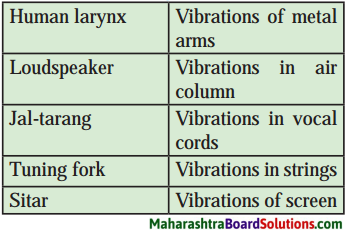
Answer:
| Column I | Column II |
| Human larynx | Vibrations in vocal cords |
| Loudspeaker | Vibrations of screen |
| Jaltarang | Vibrations in air column |
| Tuning fork | Vibrations of metal arms |
| Sitar | Vibrations in strings |
Can you recall?
Question a.
How is sound produced?
Answer:
Sound is produced by the vibrations of an object such as a stretched membrane or a string under tension.
![]()
Project:
Question 1.
Take two plastic glasses and tie a thread between them to make a toy phone. Does the voice of your friend reach you through the thread? Take metal wire instead of the thread and also change the length of the thread wire and repeat the activity. Discuss with your friends and teacher about your conclusions.
Question 2.
Take a plastic or tin can or a plastic glass. Remove its bottom. Stretch a piece of rubber balloon across one end and fix it with a rubber band. Put a few grains of say ragi or bajra on the stretched rubber. Now ask your friend to shout ‘Hoorrey ……… Hoorrey ………… ‘ from the open end of the glass. Observe the dancing of the grains up and down. Discuss the reason behind this.
Class 8 Science Chapter 15 Sound Important Questions and Answers
Select the correct option and write the completed statements:
Question 1.
Sound waves cannot travel through a ………… .
(a) solid
(b) liquid
(c) gas
(d) vacuum
Answer:
Sound waves cannot travel through a vacuum.
Question 2.
If the frequency of a sound wave is 512 Hz, the number of rarefactions produced per second is ……………… .
(a) 256
(b) 512
(c) 1024
(d) 128
Answer:
If the frequency of a sound wave is 512 Hz, the number of rarefactions produced per second is 512.
![]()
Question 3.
In the experiment to show that a medium is necessary for propagation of sound, as the quantity of air inside the bell jar decreases, the level of ringing sound heard outside ……………… .
(a) increases
(b) decreases
(c) fluctuates randomly
(d) changes at regular intervals
Answer:
In the experiment to show that a medium is necessary for propagation of , sound, as the quantity of air inside the bell jar decreases, the level of ringing sound heard outside decreases.
Find the odd one out and give the reason:
Question 1.
Sound waves, Waves on the surface of water, Waves on a stretched string, Light waves
Answer:
Light waves. Light waves can travel in a vacuum. Other waves need a medium for propagation.
Question 2.
Sitar, Violin, Guitar, Flute.
Answer:
Flute. It is not a string based instrument. Others are string based instruments.
State whether the following statements are True or False. (If a statement is false, correct it and rewrite it.)
Question 1.
If the vibrating length of a stretched string is kept constant and the tension in the string is increased, the frequency of the sound produced increases.
Answer:
True.
![]()
Question 2.
In Jaltarang, the frequency of sound produced is independent of the height of the air column inside the glass cup.
Answer:
False. (In Jaltarang, the frequency of sound produced depends on the height of the air column inside the glass cup; the more the height of the air column, the less is the frequency of the sound produced.)
Answer the following questions in one sentence each:
Question 1.
What is sound?
Answer:
Sound is a form of energy which produces sensation of hearing in our ears.
Question 2.
What is vibration?
Answer:
Vibration is a rapid, to and from periodic motion of an object about its mean position.
Question 3.
What is compression?
Answer:
As a sound wave travels through air, the region in which air is at high pressure and high density is called compression.
Question 4.
What is rarefaction?
Answer:
As a sound wave travels through air, the region in which air is at low pressure and low density is called rarefaction.
![]()
Question 5.
What is the relation between the frequency of vibration and the vibrating length (or height) of the air column?
Answer:
The greater the vibrating length (or height) of the air column, the less is the frequency of vibration of the column.
Question 6.
For a particular string (given material and radius), what are the factors on which its frequency of vibration depends?
Answer:
For a particular string (given material and radius), the frequency of vibration of the string depends upon its vibrating length and the tension in the string.
[Note: in the above case, frequency is proportional to the square root of the tension and inversely proportional to the length.]
Question 7.
Name an instrument in which a stretched skin is used to produce musical sound.
Answer:
Tabla.
![]()
Answer the following questions:
Question 1.
Explain the production and propagation of sound in air.
Answer:
Let us consider production of sound by using a tuning fork. A tuning fork is made of a metal. It has a stem and two prongs (Fig). Figure (a) shows the state of air in the absence of propagation sound through it. Equally spaced vertical lines show that the average distance between the air molecules is the same everywhere. It means average pressure and average density in the regions A, B and C are the same.
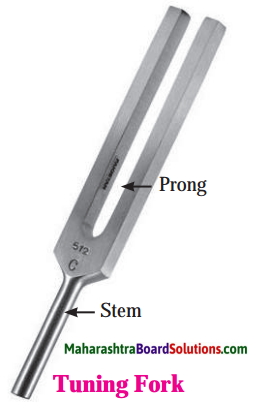

Suppose the tuning fork is held vertical, its stem is fixed in a stand (not shown in the figure) and its prongs are struck lightly using a light hammer with a piece of rubber at the top. The prongs then start vibrating.
Figure (b) shows what happens when the prongs move away from each other. The air outside the prongs is compressed (layers in the region A). The pressure and density increase in this region.
Figure (c) shows what happens when the prongs move close to each other. The air molecules near the prongs move away from each other resulting in lower pressure and lower density.
This region is called rarefaction. Meanwhile, the compression produced earlier moves forward, i.e., away from the prongs because the air molecules in this region transfer their energy to the air molecules in the region B producing a compression there. The periodic formation of compression and rarefaction results in propagation of sound waves away from the prongs.
Eventually, these sound waves reach our ears, the ear-drum vibrates, and we get a sense of hearing a sound as the specific signals reach the brain.
![]()
Use your brain power:
Question a.
If sound waves are generated in air, what moves away from the source? Is it the air itself or the state of compression and rarefaction created in the air?
Answer:
If sound waves are generated in air, the state of compression and rarefaction created in the air moves away from the source.
[Note: The air does not move away from the source because air is elastic and the force due to the tuning fork varies periodically with time.]
Question 2.
Explain the term frequency of a sound wave.
Answer:
Sound travels in the form of waves. A wave consists of cycles of alternate compression and rarefaction. The number of cycles produced in the air (or any other medium) per second is called the frequency of the sound wave. It is expressed in hertz (Hz). 1 hertz = 1 cycle per second or 1 vibration per second or 1 oscillation per second.
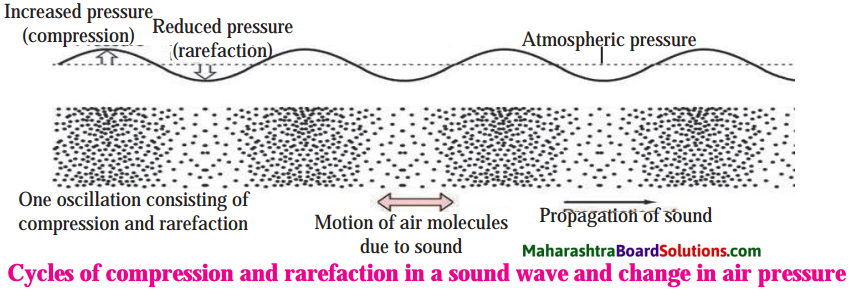
[Note: The SI unit of frequency, the hertz, is named in honour of Heinrich Hertz (1857-94), German physicist.]
![]()
Question 3.
State the factors on which the frequency of a tuning fork depends.
Answer:
The frequency of a tuning fork depends on the dimensions of the prongs, i.e., length and thickness, and the material used for making the fork.
Try this:
Question a.
Take 6 – 7 glass cups. Arrange them in a line and fill them with water with gradually increasing water level from one end to other. Take a pencil and strike the cups sequentially. The sound generated by each cup will be different. Why is it so?
Use of ICT:
Download videos of Jaltarang from youtube and send them to your friends by email.

Answer:
When a cup is struck, waves are set up in the air column above the water level in the cup. The frequency of the generated wave depends on the height of the air column inside the glass cup. Since the water level in each glass is different, the height of the air column in each glass is also different. Therefore, the frequency of sound generated by each glass cup will also be different. So, the sound generated is different.
Question b.
An ‘app’ for measurement of sound frequency may be available on cellphones. With the help of your teacher, use the app to measure the frequency of the sound generated from each glass cup. Do you observe any relation between the frequency of generated sound and the height of the air column in the glass cup?
Answer:
Yes. The greater the height of the air column in the glass cup, the less is the frequency of the sound produced.
Question c.
This is your simple ‘Jaltarang’! Can this experiment be performed with stainless steel pots of different size?
Answer:
Do it. See what happens as the stainless steel pot itself starts vibrating producing a sound. Also see how this sound is damped by water.
![]()
Do you know?
Question a.
What are the frequencies of musical notes ‘sa’, ’re’, ‘ga’, ‘ma’, ‘pa’, ‘dha’, ‘ni’ in the ‘madhya saptak’?
Answer:
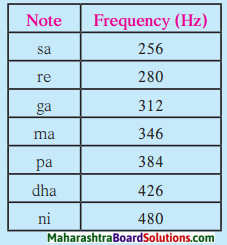
[Note: The diatonic scale:
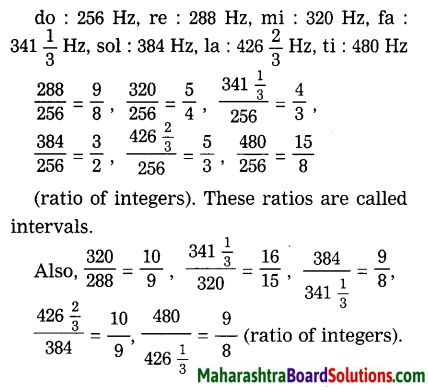
![]()
Such a simple fraction is pleasing to the ear and is called a musical interval. Frequency ratios 2 : 1, 3 : 2, 4 : 3 are examples of musical interval.
Observe and discuss:
Question 1.
Identify the instruments and discuss sound production in them. [Students should see these musical instruments.]
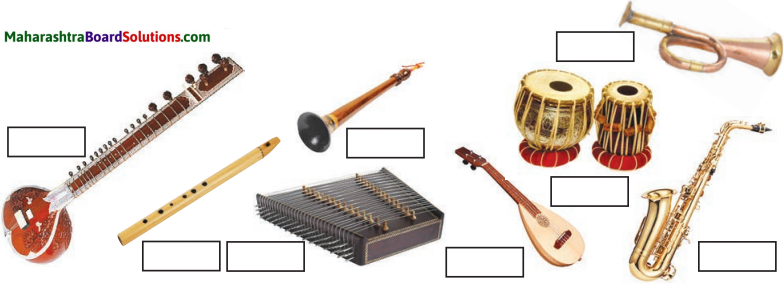
Answer:
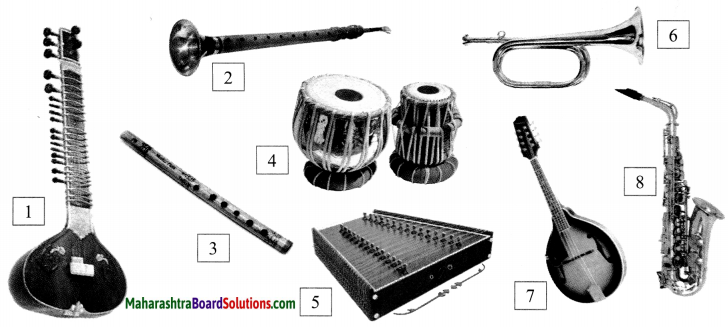
- Sitar
- Shehnai
- Flute
- Tabla
- Santoor
- Bugle
- Mandoline or Mandolin
- Saxophone.
Question i.
Sitar, Santoor and Mandoline or mandoline (String instruments):
Answer:
Vibrating strings produce the sound. The greater the tension in the string, the higher is the frequency of the sound. The greater the vibrating length and the diameter of the string, the lower is the frequency of the sound.
Question ii.
Flute, Saxophone and Shehnai (Wind instruments):
Answer:
Vibrating air column produces the sound. The greater the length of the column, the lower is the frequency of the sound.
![]()
Question iii.
Tabla (Percussion instrument):
Answer:
Vibrating skin produces the sound. The greater the tension in the skin, the higher is the frequency of the sound. The greater the thickness of the skin, the lower is the frequency of the sound.
Try this:
‘Apps’ for generation of different sound notes (sound note generator app) may be available on cellphones. With the help of your teacher, using such an app, generate sound notes listed in the table.

Vocal cords are 20 cm in length in male, about 15 cm in female and even smaller in children. Therefore the voice of male, female and children are different.
[Note: Vocal cords are 20 mm in length in male, about 15 mm in female and even smaller in children. Reference NCERT textbook Std. VIII, published in 2017.]
Question 1.
Produce a sound ‘bho … bho …’ just like a dog-barking and ‘meow … meow…’ just like a mewing cat. Carefully notice the tension on the vocal cords, when you produce these sounds. Do you feel that the tension on the vocal cords changes when you produce these two different sounds?
Answer:
Yes.
![]()
Question 2.
An ‘app’ may be available on cell-phones to measure the loudness of sound in decibel. With the help of your teacher, use the app to measure the sound level of a sound from a loudspeaker at some public place. Measure the sound level at different distances from the loudspeaker. Do you observe some relation between the distance from the loudspeaker and the sound level?
Answer:
Yes. As the distance increases, the sound level decreases.
Always remember:
We should take care that others are not disturbed when we study sound and its production. Sound pollution is a major cause affecting the environment and social health. Hence we should find ways to avoid sound pollution.